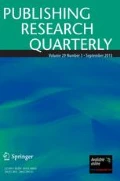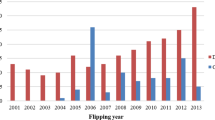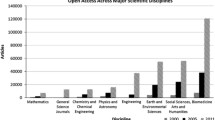Abstract
As the publishing industry evolves towards the predominant open access (OA) model, publishers are establishing OA journal power-houses, the OA mega-journals (OAMJs), which are wide in scope, with larger-than-usual editor boards, and that pump out large numbers of papers. OAMJs are thus able to accommodate a surge in submissions, or transfers from other journals within the same publisher’s fleet. OAMJs represent a simple but effective publishing model that can also be an effective business model. We question whether the peer review system is robust enough to accommodate for effective post-publication peer review in OAMJs. As examples, we examine Scientific Reports, PLOS One, Heliyon, F1000Research, PeerJ, and BMJ Open, as well as a possible developing OAMJ, eLife, for clues to the dynamics of OAMJs and the possible links to quality control via peer review or post-publication peer review. We also take a closer look at the economics of OA publishing that might be driving the expansion of the OAMJ market.
Similar content being viewed by others
Notes
https://scholarlycommunications.jiscinvolve.org/wp/2017/08/23/article-processing-charges-in-2016/; in this survey, there are several limitations that might not reflect a global trend: (1) UK-based; (2) assessment across 11 institutions; 38 publishers assessed.
eLife, which is financially supported by the Howard Hughes Medical Institute, the Max Planck Society, and the Wellcome Trust, and which charges a publishing fee (APC) of US$ 2500 per paper, pays its Editor-in-Chief, three Deputy Editors, 39 Senior Editors and almost 300 Reviewing Editors for their time https://elifesciences.org/inside-elife/b6365b76/setting-a-fee-for-publication.
https://springerplus.springeropen.com/about/springerplus-faqs (“Ultimately, we felt that SpringerPlus covered too wide a range of disciplines, from the natural sciences to engineering and the social sciences. These are very different research communities, with very different needs when submitting or transferring manuscripts, and a one-size-fits-all journal is not the solution.”).
As a hypothetical example, a “cost per journal JIF” of $2900 APC for a JIF = 2.0 journal would be rewarded less than a publication in a journal with JIF = 4.0 journal that charges an APC of $400.
https://www.protocols.io/groups/protocolsio/news/megajournals-megamyths (“The past decade has conclusively established that this model is welcome, needed, and sustainable. Just look at the explosion in the number of articles published in megajournals”; “Megajournals do not do peer review (or, they do “peer review light”). That’s a malicious myth which seems to have been intentionally spread by several authors of the publisher-funded Scholarly Kitchen. See “How a sustained misinformation campaign by Scholarly Kitchen attacked PLOS ONE’s rigorous peer review.””).
One could argue that the review process F1000Research implements does not meet the threshold of PPPR, since pre-publication peer review is absent [51].
The term “published” should, sensu lato, indicate the release of information into the public, and in that sense, F1000Research represents and uses the term accurately, as do preprint servers; many other publishers incorrectly associate “published” with having been peer reviewed.
STM 2018 report states, on page 136: “Several dedicated studies looking at levels of OA in the years 2014–2016 have also returned figures for OA content in the region of 30%, while others report substantially higher figures, in excess of 50% in some cases (see Table 1)”.
Economic profit is defined as revenue minus all costs including the opportunity cost of the shareholders’ investment into the firm. Hence, positive economic profits means the firms are making above-normal profits.
According to the 2015 STM report by Ware and Mabe, the global cost of peer review is estimated at £1.9 billion annually. This translated to an estimate of £1200 per paper [22] or US$1656 (April 30, 2018 exchange rate: 1 £GB = 1.38 US$; https://www.xe.com/). Houghton et al. [15] estimated a higher true cost of peer review at £1400 per paper or US$1932 (April 30, 2018 exchange rate). These hidden costs are not far from the average APC being charged by OAMJs. These are full costs and include reviewers’ time.
Christensen [12] coined the term “innovative disruptions” as events that cause turmoil in an established market causing profound and permanent changes in the structure. Examples include Google, Apple, Uber and AirBnB. For innovative disruptions see: http://www.claytonchristensen.com/key-concepts/.
Assuming a 6.7% continued growth starting from 2.4 million articles published in 2013.
This number might be a large underestimate of the real number of academics that publish. According to ResearchGate, an academic social networking site, there are currently in excess of 15 million academics: https://www.researchgate.net/about.
We assume that there are also publishing entities that will publish anything for a zero APC without peer review or with weak peer review, with the sole objective of increasing their volume of published literature and profile. Such publishers take a slice of the orphan papers, depriving other legitimate publishers from collecting potential APCs. Such unscholarly players thus also represent a financial threat.
However, Solomon does not examine how many papers the other journals published that were previously rejected by yet other journals and hence one cannot argue that OAMJs publish lower quality work because there is no control group against which quality can be compared.
“PLOS ONE’s instructions for authors indicates the publisher will help in transferring manuscripts from one PLOS journal to another but encourage authors to carefully consider which PLOS journal would be most appropriate for their manuscript before submission.” (p. 6).
According to Christensen, disruptive innovation “describes a process by which a product or service takes root initially in simple applications at the bottom of a market and then relentlessly moves up market, eventually displacing established competitors.” See: http://www.claytonchristensen.com/key-concepts/.
References
Al-Khatib A, Teixeira da Silva JA. Threats to the survival of the author-pays-journal to publish model. Publishing Research Quarterly. 2017;33(1):64–70. https://doi.org/10.1007/s12109-016-9486-z.
Allison DB, Brown AW, George BJ, Kaiser KA. Reproducibility: a tragedy of errors. Nature. 2016;530(7588):27–9. https://doi.org/10.1038/530027a.
Anonymous (Editorial). Retraction challenges. Cleaning up the literature can be difficult. Nature. 2014;514:5. https://doi.org/10.1038/514005a.
Arms WY. What are the alternatives to peer review? Quality control in scholarly publishing on the web. J Electron Publ. 2002. https://doi.org/10.3998/3336451.0008.103.
Beall J. Five predatory mega-journals: a review. Charlest Advis. 2013;14(4):20–5.
Björk B-C. Have the “mega-journals” reached the limits to growth? PeerJ. 2015;3:e981. https://doi.org/10.7717/peerj.981.
Björk B-C. Evolution of the scholarly mega-journal, 2006–2017. PeerJ. 2018;6:e4357. https://doi.org/10.7717/peerj.4357.
Björk B-C. Publishing speed and acceptance rates of open access megajournals. Online Inf Rev. 2018. https://doi.org/10.1108/oir-04-2018-0151.
Björk B-C, Solomon D. Article processing charges in OA journals: relationship between price and quality. Scientometrics. 2015;103(2):373–85. https://doi.org/10.1007/s11192-015-1556-z.
Buriak JM. Mega-journals and peer review: can quality and standards survive? Chem Mater. 2013;27(7):2243. https://doi.org/10.1021/acs.chemmater.5b01142.
Chua S, Qureshi AM, Krishnan V, Pai DR, Kamal LB, Gunasegaran S, Afzal MZ, Ambawatta L, Gan J-Y, Kew PY, Winn T, Sood S. The impact factor of an open access journal does not contribute to an article’s citations [version 1]. F1000Research. 2017;6:208. https://doi.org/10.12688/f1000research.10892.1.
Christensen CM. The innovator’s dilemma: when new technologies cause great firms to fail. Boston: Harvard Business School Press; 1997.
Else H. Radical open-access plan could spell end to journal subscriptions. Nature. 2018;561:17–8. https://doi.org/10.1038/d41586-018-06178-7.
Extance A. Could bitcoin technology help science? Nature. 2017;552:301–2. https://doi.org/10.1038/d41586-017-08589-4.
Houghton JW, Oppenheim C, Morris A, Creaser C, Greenwood H, Summers M, Gourlay A. Economic implications of alternative scholarly publishing models. A report to the joint information systems committee, (JISC). http://vuir.vu.edu.au/15222/1/EI-ASPM_Report.pdf (2009). Last Accessed 11 Apr 2019.
Johnson R, Watkinson A, Mabe M. 2018 STM: International Association of Scientific, Technical and Medical Publishers, Fifth Edition published October 2018, International Association of Scientific, Technical and Medical Publishers, Prins Willem Alexanderhof 5, The Hague, 2595BE, The Netherlands. http://www.stm-assoc.org/2018_10_04_STM_Report_2018.pdf (2018). Last Accessed 11 Apr 2019.
Larivière V, Haustein S, Mongeon P. The oligopoly of academic publishers in the digital era. PLoS ONE. 2015;10(6):e0127502. https://doi.org/10.1371/journal.pone.0127502.
Lăzăroiu G. Do mega-journals constitute the future of scholarly communication? Educ Philos Theory. 2017;49(11):1047–50. https://doi.org/10.1080/00131857.2017.1300022.
Liu J, Adie E. Five challenges in altmetrics: a toolmaker’s perspective. Bull Am Soc Inf Sci Technol. 2013;39(4):31–4. https://doi.org/10.1002/bult.2013.1720390410.
Plume A, van Weijen D. Publish or perish? The rise of the fractional author. Res Trends. 2014;38(3):16–8.
Randall D, Welser C. The irreproducibility crisis of modern science: causes, consequences, and the road to reform. National Association of Scholars. https://www.nas.org/projects/irreproducibility_report (2018). Last Accessed 11 Apr 2019.
RIN. Activities, costs, and funding flows in the scholarly Communication system in the UK. Research Information systems. http://www.rin.ac.uk/system/files/attachments/Activites-costs-flows-report.pdf (2008). Last Accessed 11 Apr 2019.
Rivara FP, Easley TJ, Flanagin A, Bauchner H. Announcing JAMA Network Open—a new journal from the JAMA network. JAMA. 2017;318(13):1230–2. https://doi.org/10.1001/jama.2017.11830.
Solomon DJ. A survey of authors publishing in four megajournals. PeerJ. 2014;2:e365. https://doi.org/10.7717/peerj.365.
Spezi V, Wakeling S, Pinfield S, Creaser C, Fry J, Willett P. Open-access mega-journals: the future of scholarly communication or academic dumping ground? A review. J Doc. 2017;73(2):263–83. https://doi.org/10.1108/JD-06-2016-0082.
Spezi V, Wakeling S, Pinfield S, Fry J, Creaser C, Willett P. “Let the community decide”? The vision and reality of soundness-only peer review in open-access mega-journals. J Doc. 2018;74(1):137–61. https://doi.org/10.1108/JD-06-2017-0092.
Sugimoto CR, Larivière V, Ni C, Cronin B. Journal acceptance rates: a cross-disciplinary analysis of variability and relationships with journal measures. J Informetr. 2013;7(4):897–906. https://doi.org/10.1016/j.joi.2013.08.007.
Swauger S. Open access, power, and privilege: a response to “What I learned from predatory publishing”. College Res Librar News. 2017;78(11):603–606.
Teixeira da Silva JA. Science watchdogs. Acad J Interdiscip Stud. 2016;5(3):13–5. https://doi.org/10.5901/ajis.2016.v5n3p13.
Teixeira da Silva JA. The journal impact factor (JIF): science publishing’s miscalculating metric. Acad Quest. 2017;30(4):433–41. https://doi.org/10.1007/s12129-017-9671-3.
Teixeira da Silva JA. Does China need to rethink its metrics- and citation-based research rewards policies? Scientometrics. 2017;112(3):1853–7. https://doi.org/10.1007/s11192-017-2430-y.
Teixeira da Silva JA. Fake peer reviews, fake identities, fake accounts, fake data: beware! AME Med J. 2017;2:28. https://doi.org/10.21037/amj.2017.02.10.
Teixeira da Silva JA. Intellectual phishing, hidden conflicts of interest and hidden data: new risks of preprints. J Advocacy Res Educ. 2017;4(3):136–46.
Teixeira da Silva JA. Preprints: ethical hazard or academic liberation? KOME. 2017;5(2):73–80. https://doi.org/10.17646/KOME.2017.26.
Teixeira da Silva JA. Preprints should not be cited. Curr Sci. 2017;113(6):1026–7.
Teixeira da Silva JA. The preprint wars. AME Med J. 2017;2:74. https://doi.org/10.21037/amj.2017.05.23.
Teixeira da Silva JA. The illicit and illegitimate continued use of Jeffrey Beall’s “predatory” open access black lists. J Radic Librariansh. 2018;4:1–5.
Teixeira da Silva JA. The preprint debate: what are the issues? Med J Armed Forces India. 2018;74(2):162–4. https://doi.org/10.1016/j.mjafi.2017.08.002.
Teixeira da Silva JA. Challenges to open peer review. Online Inf Rev. 2019;43(2):197–200. https://doi.org/10.1108/OIR-04-2018-0139.
Teixeira da Silva JA, Adjei KOK, Owusu-Ansah CM, Sooryamoorthy R, Balehegn M. Africa’s challenges in the OA movement: risks and possibilities. Online Inf Rev. 2019. https://doi.org/10.1108/oir-04-2018-0152 (in press).
Teixeira da Silva JA, Al-Khatib A, Dobránszki J. Fortifying the corrective nature of post-publication peer review: identifying weakness, use of journal clubs, and rewarding conscientious behavior. Sci Eng Ethics. 2017;23(4):1213–26. https://doi.org/10.1007/s11948-016-9854-2.
Teixeira da Silva JA, Bernès S. Clarivate analytics: continued omnia vanitas impact factor culture. Sci Eng Ethics. 2018;24(1):291–7. https://doi.org/10.1007/s11948-017-9873-7.
Teixeira da Silva JA, Dobránszki J. Notices and policies for retractions, expressions of concern, errata and corrigenda: their importance, content, and context. Sci Eng Ethics. 2017;23(2):521–54. https://doi.org/10.1007/s11948-016-9769-y.
Teixeira da Silva JA, Dobránszki J, Al-Khatib A, Tsigaris P. Challenges facing the DOAJ (directory of open access journals) as a reliable source of open access publishing venues. J Educ Med Libr Sci. 2018;55(3):349–58. https://doi.org/10.6120/JoEMLS.201811_55(3).e001.BC.BE.
Teixeira da Silva JA, Katavić V. Free editors and peers: squeezing the lemon dry. Ethics Bioeth. 2016;6(3–4):203–9. https://doi.org/10.1515/ebce-2016-0011.
Teixeira da Silva JA, Memon AR. CiteScore: a cite for sore eyes, or a valuable, transparent metric? Scientometrics. 2017;111(1):553–6. https://doi.org/10.1007/s11192-017-2250-0.
Teixeira da Silva JA, Ruan C-J, Yu X-N, Zeng S-J. International collaboration, scientific ethics and science writing: focus on China. Asian Aust J Plant Sci Biotechnol. 2013;7(Special Issue 1):38–45.
Teixeira da Silva JA, Shaughnessy MF. An interview with Jaime A. Teixeira da Silva: insight into improving the efficiency of the publication process. North Am J Psychol. 2017;19(2):325–38.
Teixeira da Silva JA, Tsigaris P. What value do whitelists and blacklists have in academia? J Acad Librariansh. 2018;44(6):781–92. https://doi.org/10.1016/j.acalib.2018.09.017.
The PLOS ONE Editors. Retraction: percutaneous aspiration thrombectomy for arterial thromboembolism during infrainguinal endovascular recanalization. PLoS ONE. 2018;13(4):e0196768. https://doi.org/10.1371/journal.pone.0196768.
Vines T. How rigorous is the post-publication review process at F1000 research? The Scholarly Kitchen. Retrieved from http://scholarlykitchen.sspnet.org/2013/03/27/how-rigorous-is-the-post-publication-review-process-at-f1000-research (2013).
Wakeling S, Creaser C, Pinfield S, Fry J, Spezi V, Willett P, Paramita M. Motivations, understandings, and experiences of open-access mega-journal authors: results of a large-scale survey. J Assoc Inf Sci Technol. 2019. https://doi.org/10.1002/asi (in press).
Wakeling S, Willett P, Creaser C, Fry J, Pinfield S, Spezi V. Open-access mega-journals: a bibliometric profile. PLoS ONE. 2016;11(11):e0165359. https://doi.org/10.1371/journal.pone.0165359.
Wakeling S, Willett P, Creaser C, Fry J, Pinfield S, Spezi V. Transitioning from a conventional to a ‘mega’ journal: a bibliometric case study of the journal. Med Publ. 2017;5:7. https://doi.org/10.3390/publications5020007.
Wakeling S, Spezi V, Creaser C, Fry J, Pinfield S, Willett P. Open access megajournals: the publisher perspective (part 2: operational realities). Learn Publ. 2017;30(4):313–22. https://doi.org/10.1002/leap.1118.
Ware M, Mabe M. An overview of scientific and scholarly journal publishing, STM report (4th edn). https://www.stm-assoc.org/2015_02_20_STM_Report_2015.pdf (2015). Last Accessed 11 Apr 2019.
Wei LM, Zhu YQ, Liu F, Zhang PL, Li XC, Zhao JG, Lu HT. Percutaneous aspiration thrombectomy for arterial thromboembolism during infrainguinal endovascular recanalization. PLoS ONE. 2015;10(10):e0140494. https://doi.org/10.1371/journal.pone.0140494.
Wellen R. Open access, megajournals, and MOOCs: on the political economy of academic unbundling. SAGE Open. 2013;3(4):1–16. https://doi.org/10.1177/2158244013507271.
Author’s Contribution
All authors are co-corresponding authors. All authors contributed equally to the intellectual discussion underlying this paper, literature exploration, writing, reviews and editing, and accept equal responsibility for the content and analyses therein.
Author information
Authors and Affiliations
Corresponding authors
Additional information
Publisher's Note
Springer Nature remains neutral with regard to jurisdictional claims in published maps and institutional affiliations.
Rights and permissions
About this article
Cite this article
Teixeira da Silva, J.A., Tsigaris, P. & Al-Khatib, A. Open Access Mega-Journals: Quality, Economics and Post-publication Peer Review Infrastructure. Pub Res Q 35, 418–435 (2019). https://doi.org/10.1007/s12109-019-09654-8
Published:
Issue Date:
DOI: https://doi.org/10.1007/s12109-019-09654-8




